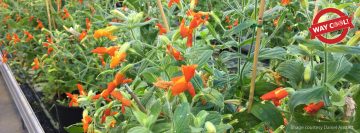
Climate change is leading to variable water availability around the world. The severity of droughts are increasing, which could make a once in a century drought the new normal. In California, a massive drought occurred between 2012 and 2015. It placed strains on plants that grow along moving water in the mountains of California and Oregon.

Join Dr. Daniel Anstett, Banting & Killam Postdoctoral Fellow at UBC’s Department of Botany, to examine the fate of the hummingbird-pollinated plant, scarlet monkeyflower. This is a story about seven years of fieldwork in the mountains of California and a massive 3000 plant greenhouse drought experiment. The key question is if scarlet monkeyflower can evolve the ability to avoid or withstand drought within only seven years.
Since the time of Darwin, evolution was considered to be a slow process taking thousands to millions of years to complete. However, new work has shown that evolution can occur within a few generations, perhaps quickly enough to limit ecological damage caused by climate change. It’s more than monkey business – ultimately monkeyflower may be able to survive climate change because of evolution, and that is way cool!
